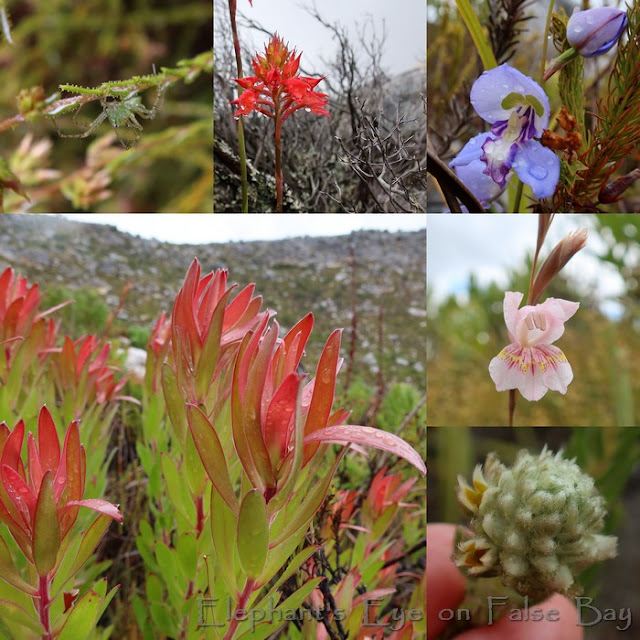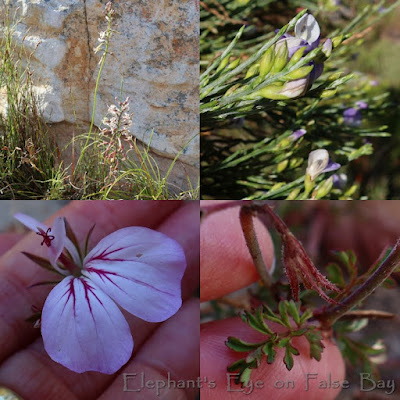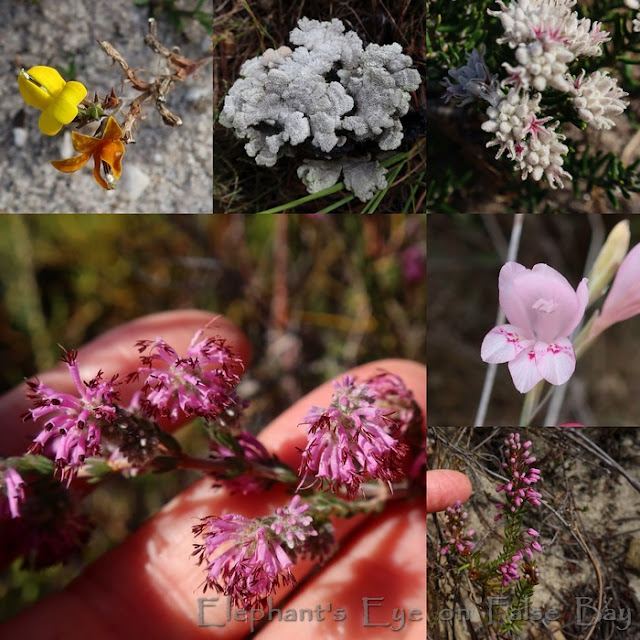March hikes to Steenberg, Silvermine, Smitswinkel, Chapman's and Elsie's Peaks, Jonkersdam
by Diana Studer
- gardening for biodiversity
in Cape Town, South Africa
Hiking among wildflowers
in the mountains
around Cape Town
Fynbos Ramble to Steenberg. Translucent green Peucetia spider. Bright scarlet Disa ferruginea and vivid blue Disa graminifolia on a misty day. Emerging leaves on Leucadendron laureolum shimmering silvery red. Each Gladiolus brevifolius plant has markings on the lip just that little bit different. Furry Phylica imberbis flowers opening.
 |
| Leucadendron at Steenberg in March |
Our second rehab hike for the Ungardener's knee. I missed my usual turn left, and found myself with him on the Panorama Route at Silvermine. Right so, you can now go back to your usual mountain hikers, I am done! (His first hike back with them was up Table Mountain, cable car not running due to wind, LONG walk back down Diagonal - almost finished him off)
 |
| Ungardener on the Panorama Route in Silvermine |
But worth it for this perfect blue Disa graminifolia.
 |
| Disa graminifolia Silvermine March |
Then the Aspalathus capitata which wasn't blooming when we looked for it on Silvermine Crags.
 |
| Aspalathus capitata Silvermine March |
To Smitswinkel Bay. A wary African black oystercatcher resting on the granite boulder. Phylica ericoides has leaves with the margins rolled back. Winding down past the holiday homes to the beach for Brunsvigia orientalis across the firebreak above the houses. Erica parviflora only a few plants surviving along the stream. Limonium scabrum we almost missed, low with a few flowers.
 |
| Brunsvigia orientalis Smitswinkel in March |
African peach for the shape - fruit is a hard shell Kiggelaria africana. Limy yellow is an UNusual colour for a pelargonium (no leaves while it flowers) - Pelargonium gibbosum. Bunches of tiny white flowers Cassine peragua barbara. Tall fluffy daisy Helichrysum pandurifolium. A nother yellow daisy, but this marshy one, furry with many short narrow petals Pulicaria scabra.
 |
| Smitswinkel daisies in March |
Teatime on the beach where the rocks fascinate me. One small one comes home with me.
 |
| Rocks at Smitswinkel Bay |
Chapman's Peak to the saddle. Silvery mauve Drimia media, a soft colour that needs to be noticed. Psoralea aphylla as the tiny leaves are laid against the stem. Pelargonium suburbanum bipinnatifidum (always look at the leaves)
 |
| Chapman's Peak Saddle in March |
Howling gale blew me over once. I sat happily, sheltered below the path, with the view! Find yourself a comfortable rock, continue your chat, or sit quietly and let last week drift away, while you recharge your batteries for the week ahead.
 |
| From Chapman's Peak saddle |
Familiar route around Elsie's Peak. Mustardy yellow Athanasia dentata. Deep red with maroon on the lip Tritoniopsis triticea. Erica pulchella has a tight spike of small flowers. Our target was Erica viscaria (one of the sticky ones, which is a defence against nectar thieves)
 |
| Elsie's Peak in March |
Long time since we have walked Jonkersdam trail. Monopsis lutea bright yellow, scattered flowers. Splitgill mushroom Schizophyllum commune. Clear pink stars emerge from furry white buds Trichocephalus stipularis is related to phylicas. Erica similis with whorled leaves (look closely the dark anthers are V-shaped). A tiny pink Erica nudiflora.
 |
| Jonkersdam in March |
We are coming up to the next City Nature Challenge 29 April to 2 May. I enjoy identifying as much as I can as far as I can. My first loyalty to my Cape Peninsula, this time with extra spiders - but fynbos always wins - so spreading my focus across the Western Cape. And also, aim high, for the Rest of Africa (with Botswana, Zimbabwe and Nigeria competing this year)!
The ten most observed species for Cape Town in 2021, which are easy to pick out, freeing up skilled identifiers for the more interesting and unusual.
Our hikes are listed on my page.
I invite you to join us at Elephant's Eye on False Bay. Please subscribe as you prefer
via Feedly,
or my Facebook blog page
Pictures by Diana Studer
of Elephant's Eye on False Bay
Teal blue text is my links.
To read comments if you are in a Reader,
first click thru to the blog)
Thanks for comments that add value. Your comment will not appear until I've read it. No Google account? Use Anonymous, then please include a link to your own blog. I welcome comments on posts from the last 2 months.

What a beautiful hike. Glad you weren't blown away. Have a great weekend. xo Laura
ReplyDeleteSome day I hope to get to your part of the world...for the plentiful plants and flowers, the amazing hikes and so many other reasons. Find yourself a comfortable rock, indeed. Thanks for sharing!
ReplyDeleteI'm glad you're back to your hikes and offering another fabulous survey of the wildflowers you find in the process. I was intrigued by the translucent spider and I adored the Disa graminifolia. The scenery in both the panoramic views you offered was spectacular. It was interesting to see new-to-me species of flowers in genera I actually have some acquaintance with, like Pelargonium, Drimia and Phylica, too.
ReplyDeleteA wonderful hike! I enjoy seeing your plant life, some of which are familiar to me as garden plants, and others that are new to me. Have a good weekend!
ReplyDeleteWhat a beautiful hike! The view from Chapman's peak is gorgeous!
ReplyDeleteSuch wonderful photos! The views! Especially Panorama Route and Chapman's Peak Saddle. Amazing! :)
ReplyDeleteSeeing all these beautiful flowers lifts my heart.
ReplyDeleteAmalia
xo
What beautiful views, how lucky you are to live near there!
ReplyDeleteThat Brunsvigia orientalis is amazing, as is that view! What I don't understand is how you have as many wildflowers in the autumn as in the spring. The Mediterranean climate here around the Med tends to be very dry by the end of summer with few wild flowers. You are lucky!
ReplyDeleteOur flower year starts in March with the autumn rain. January and February are the hottest months, when the fynbos rests.
Delete